Choosing the Right Casters
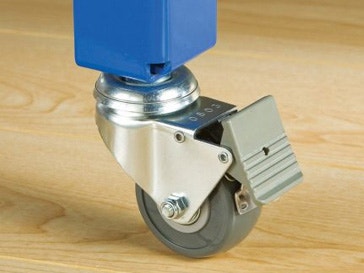
It's just a wheel, right? If only it were that simple. Caster Wheels are available in a huge range of sizes, styles, materials, and with numerous swiveling, braking and locking options.
This can make choosing the right one feel more than a bit intimidating. But no need to worry. This comprehensive guide will lay out all the options, and their pros and cons, so you can feel confident about your choice.
Mounting Type—Plate-Mount or Stem-Mount?
Casters are available in two broad mounting types: plate-mount, which is mounted with four bolts or screws fed through a thick rectangular plate, and stem-mount, so named for its narrow stem, which fits into a corresponding sleeve or hole. Read on below to learn about the pros and cons of each.
Choose Plate-Mount for Versatility and Heavy-Duty Performance
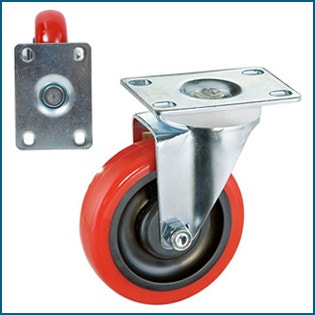
Thanks to their wide, thick mounting plates, plate-mount casters are generally more sturdy and have a higher weight capacity than stem-mount casters. Plate mount casters also offer easy surface mounting to a variety of surfaces. Since they're offered in both rigid and swiveling models, and are available with more locking features, plate mount casters are the mainstay of shop carts and mobile workstations.
Choose Stem-Mount for Easy Replacement or for Mounting to Legs
The advantage of stem mount casters is that they are easily removable for future replacement. Stem mount casters are also sometimes required where the mounting location is small, such as at the end of a table leg, bench leg or cart leg. Keep in mind that stem mount casters are only offered in swiveling varieties. If you want non-swiveling (rigid) casters for their straight tracking ability, then you'll need to buy plate-mount models.
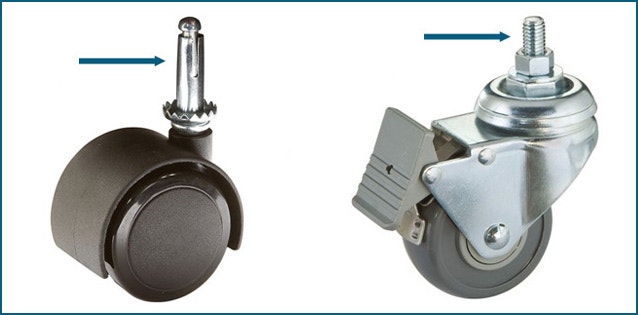
Two sub-types of stem-mount casters are also available: smooth stem (often called "grip ring") and threaded stem. Smooth stem casters slide into a corresponding sleeve that clicks into a groove on the stem. These are the easiest to replace, and are generally made for lighter-duty applications like furniture. Threaded stem casters, such as those offered for our work stands are secured with a heavy nut and washer, and are generally more sturdily built. If you are replacing existing stem-mount casters, be sure to match the diameter and length of the stem with the new casters.
Steering and Tracking — Rigid or Swivel?
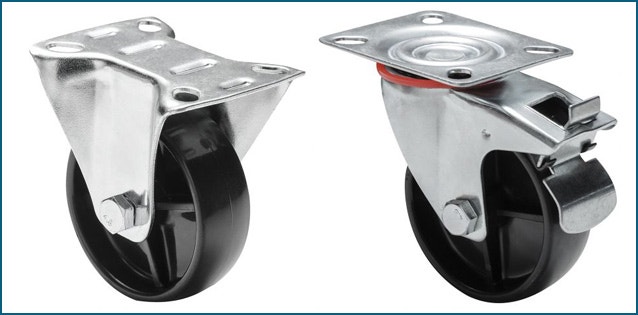
If you choose plate-mount casters, you get a choice between two movement types: rigid and swivel. Rigid casters track in one direction, in a straight line, just like the rear wheels of a grocery cart. They cannot move sideways unless you lift them off the ground. Swivel casters, on the other hand, rotate 360° for easy steering. A popular configuration is to have two rigid casters for straight tracking, and two swivel casters for steerability, just like a grocery cart. However, if your space is small, has tight corners, or you want to be able to move your cart directly sideways, then you may want all four casters to swivel.
Shop All Rigid casters and Shop All Swivel casters.
 |
Caster TipNever drag a rigid caster sideways. This is a sure-fire way to create flat spots, which will only get bigger over time, and you can even tear the tire off of the hub if the load is heavy. If your shop requires sideways movement, make it easy on yourself and your casters by going with all swiveling. |
Braking and Locking Options — Wheel Lock or Total Lock?
Casters are available with two primary locking options for when more stationary stability is needed. The first is a "wheel lock" or "brake," which prevents the wheel from rotating. This is useful to keep carts from rolling away because of a slope, wind or other forces. However, wheel locks don't prevent swivel casters from swiveling, so they will still "swim around" within a narrow range. If used on a workstation, this becomes a problem. To solve it, Total Lock casters prevent both the wheel from rotating and the caster housing from swiveling, resulting in maximum stability for wheeled workstations. When Total Locks are engaged, the cart or stand becomes very rigid and stable, almost as if it had no casters at all.
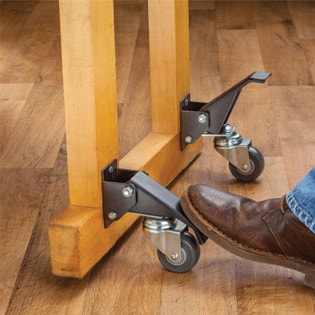
 |
Caster TipFor a top-performing workbench caster that offers unmatched stability, check out the Rockler Workbench Casters. Just a flip of the foot-lever puts them on the most stable possible footing—the bench's own legs. |
Tire/Wheel Types — Single-Wheel, Twin-Wheel or Ball-Wheel?
Single-wheel casters are the most common type of caster, and are good for most general-purpose applications. Since they are so common, they are typically available in a wide range of materials, sizes and styles, allowing you to match the caster to your needs.
For heavier loads, twin-wheel casters offer two advantages. First, all other things the same, they hold more weight because the twin wheels distribute weight over a larger area. Second, twin wheels reduce the "scrubbing" action of wide tires. To understand "scrubbing," think of the gravelly noise you hear when you crank the steering wheel of a stationary car. With twin-wheel casters, the outer tire turns at a different rate than the inner tire, resulting in less friction and smoother steering. Twin wheel casters are common on office chairs and other furniture that needs to turn on a dime in tight quarters.
The final wheel type, ball wheel, is primarily used on fine furniture. Ball casters are generally offered in smaller diameters, often with various metal finishes on the housings, and even with polished fenders, all of which add to their subtlety and visual appeal.
What Wheel Diameter Should I Choose?
Casters are offered in a wide range of diameters from roughly 1-1/2" to 5". The diameter you choose will depend on a variety of factors, including the type of floor (hard surface or carpeted), the condition of the floor, any door thresholds you have to cross, and the likelihood that there will be debris on the floor.
Choose Larger Wheels for Smoother Rolling

In general, larger diameter wheels will roll more smoothly, with less effort, won't bog down on carpets and mats, and won't get hung up on cracks, pebbles, strips of scrap wood and cords. Note that you should never roll over cords if you can help it, but if you accidentally do, it's better for the caster to roll over it than to suddenly stop and skid, which can tear the insulation off of the cord. Larger diameter wheels are also useful if there is a specific standover height required in order to clear obstacles.
Choose Smaller Wheels for Lower Center of Gravity

Smaller diameter wheels will have a lower center of gravity, which helps to stabilize the load and prevent tipping. They also reduce the standover height, which maximizes storage space in mobile cabinets. There are also some situations where the higher rolling resistance of a small wheel is actually desirable. A smooth floor and a slight slope, for example, can cause carts with large casters to drift away on their own, or make them hard to stop when the load is heavy.
What Material for the Tires/Wheels?

Your choice of tire material will depend on several factors, including cosmetic appearance, friendliness to your flooring materials, and how much rolling noise is acceptable. If your floor is made of a scratch-prone material like hardwood, consider a softer tire like polyurethane, rubber or PVC. Softer materials also provide a quieter ride, ideal for interior applications. If you need the caster to be harder for less rolling resistance, but don't want black marks on your floor, consider a non-marking polyolefin caster. Cosmetic or decorative caster materials, like hardwood and porcelain, are used on fine furniture to match a certain aesthetic. They are not designed for heavy use, but are still practical when moving furniture around occasionally.
What About Weight Rating?
This one is pretty straightforward—never exceed the weight capacity of your casters. In fact, figure out the maximum weight your cart will carry and buy casters with load ratings that exceed that number by a healthy margin. Another thing to consider when it comes to load capacity is whether your wheeled item will sit in one spot for a long time. If it will, it can develop flat spots on the casters. To avoid this, opt for harder wheel materials, and again, leave a good safety margin for the weight capacity. If you do, your casters will last much longer, you'll have less rolling resistance, and you'll be much happier in the long run.
 |
Caster TipBe sure to consider whether the listed weight capacity is for a single caster or a set! Casters that are sold as a set often list the total weight capacity. |
Remember That Furniture Glides Are Sometimes an Option

If your furniture item will only be moved occasionally, a glide will often do the trick in place of a caster. Furniture Glides are offered in a range of sizes to suit your needs. In general, larger diameter glides will slide better on carpet. You can even buy glides that slide across the floor easily when tilted, but stay in place when the item is in its usual position.
Hopefully these tips will get you rolling in the right direction when selecting your casters! Don't forget that we have expert staff in our retail stores and online to help out if you have a question that's not answered here.
shop all Casters
Keep the inspiration coming!
Subscribe to our newsletter for more woodworking tips and tricks